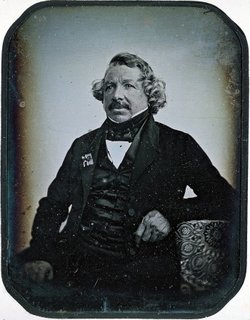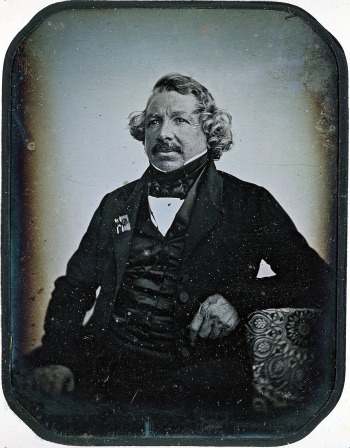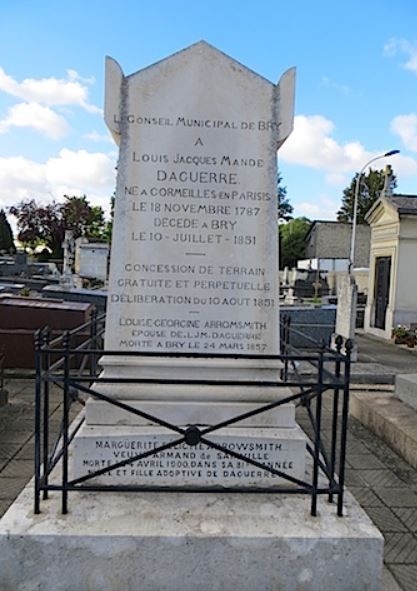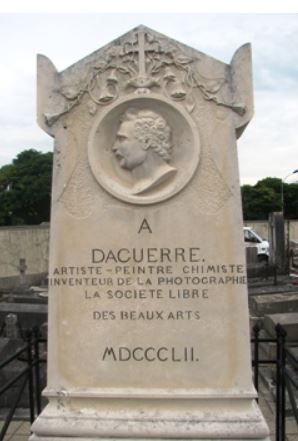Inventor. He was a French painter and physicist during the 19th century, who invented the first practical process of photography, the daguerreotype. Although the first photograph was made in 1826 by another Frenchman, Nicephore Niepce. Daguerre's process required only 30 minutes to developed, whereas Niepce's required eight hours to develop and then it was of a poor quality. He had studied architecture and had been employed as a painter of background scenes in the Paris Opera House. In 1822 he opened in an exhibition of pictorial views, some with sacred images, that have a realistic appearance caused by manipulating the lighting from candles or using natural light. This was called a Diorama, and he established one in London, which burnt to the ground in 1839. In 1829, he and Niepce became partners experimenting in methods to make photographs. To be used in the Diorama, the two men produced 21 paintings on transparent canvas with some measuring 70 feet by 45 feet. After Niepce's sudden 1833 death, Daguerre continued the experiments and discovered that exposing an iodized silver plate in a camera would result in a lasting image. On January 9, 1839, the full description of the daguerreotype process was presented by Francois Arago to a joint meeting of the Academy of the Arts and the French Academy of Sciences. Daguerre was appointed an Officer of the Legion of Honor and he was given 6,000 francs by the French government for the process. The heirs of Niepce were given 4,000 francs. He patented the photographic process in England, but the French government revealed the process to the world like a gift with instruction booklets in a number of languages. After several years of widespread popularity, the use of the daguerreotype began to decline as newer and more advanced cameras were made, but he had become a very wealthy man by the time of his death. Daguerre's name is one of the 72 inscribed on the Eiffel Tower in Paris. In 1890, the Professional Photographers of America donated a marble and bronze monument to Daguerre to be placed at the Arts and Industries building in Washington, D.C. In 1989, the monument was relocated to outside the National Portrait Gallery and rededicated. The inscription on the monument documents his contribution to photography, to the steam engine and electric telegraph. His home town of Bry-sur-Marne is very proud of its diorama. The paintings used for the diorama are displayed in St. Gervaise and St. Protai C hurch. A bust of Daguerre is located on a column in a small garden across the street from the church.
Inventor. He was a French painter and physicist during the 19th century, who invented the first practical process of photography, the daguerreotype. Although the first photograph was made in 1826 by another Frenchman, Nicephore Niepce. Daguerre's process required only 30 minutes to developed, whereas Niepce's required eight hours to develop and then it was of a poor quality. He had studied architecture and had been employed as a painter of background scenes in the Paris Opera House. In 1822 he opened in an exhibition of pictorial views, some with sacred images, that have a realistic appearance caused by manipulating the lighting from candles or using natural light. This was called a Diorama, and he established one in London, which burnt to the ground in 1839. In 1829, he and Niepce became partners experimenting in methods to make photographs. To be used in the Diorama, the two men produced 21 paintings on transparent canvas with some measuring 70 feet by 45 feet. After Niepce's sudden 1833 death, Daguerre continued the experiments and discovered that exposing an iodized silver plate in a camera would result in a lasting image. On January 9, 1839, the full description of the daguerreotype process was presented by Francois Arago to a joint meeting of the Academy of the Arts and the French Academy of Sciences. Daguerre was appointed an Officer of the Legion of Honor and he was given 6,000 francs by the French government for the process. The heirs of Niepce were given 4,000 francs. He patented the photographic process in England, but the French government revealed the process to the world like a gift with instruction booklets in a number of languages. After several years of widespread popularity, the use of the daguerreotype began to decline as newer and more advanced cameras were made, but he had become a very wealthy man by the time of his death. Daguerre's name is one of the 72 inscribed on the Eiffel Tower in Paris. In 1890, the Professional Photographers of America donated a marble and bronze monument to Daguerre to be placed at the Arts and Industries building in Washington, D.C. In 1989, the monument was relocated to outside the National Portrait Gallery and rededicated. The inscription on the monument documents his contribution to photography, to the steam engine and electric telegraph. His home town of Bry-sur-Marne is very proud of its diorama. The paintings used for the diorama are displayed in St. Gervaise and St. Protai C hurch. A bust of Daguerre is located on a column in a small garden across the street from the church.
Bio by: Linda Davis
Family Members
Advertisement
See more Daguerre memorials in:
Records on Ancestry
Sponsored by Ancestry
Advertisement





